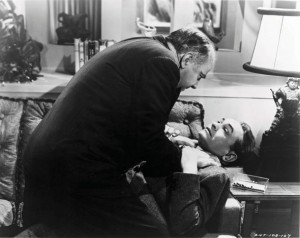Ah, it was all a dream! Leaving the club, he’s reassured that the hatcheck man looks just like Mazard, the man he was supposed to have murdered. At the club entrance, he’s relieved again, even doing a double take, to see the doorman, who looks just like Heidt the blackmailer, killed by the police in that dream. But here is a script flaw: although Wanley had discussed with Alice how to handle her blackmailer, he had never met Heidt.
Not sure I completely accept the dream explanation—logically or as a satisfactory ending for this type of film—but it caught me off guard, for shame.
And as for the last scene, it seems inappropriate after all that dark, shadowy, rainy film noir: as Wanley steps outside the club, he walks over to the store window and once again admires the beautiful portrait. Where before it had been Joan Bennett’s reflection in the plate glass, which had started everything, now appears a different reflection. Standing beside him on the sidewalk, the woman asks for a light for her cigarette. Wanley hesitates and finally blurts out, “No. Oh, no. Thank you indeed.” He then runs off, shouting, “Not for a million dollars.”
It’s just a little too flippant, a little too cute, this ending. This, after all, isn’t a comedy; it’s an excellent drama which deserves a little better. Or, on the other hand, perhaps this is a well thought out complement to the dream revelation. Anyway, don’t wait as long as I did before seeing The Woman in the Window.
A wonderful film, Eddie G. is the best…he swallows the screen whole in whatever film he is in. I have the 1931 Clark Firefly lighter Robinson uses to light Bennett’s cigarette while they’re having drinks. It still works.